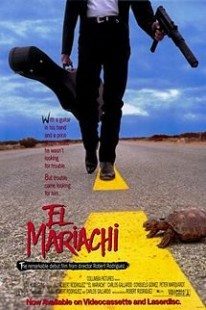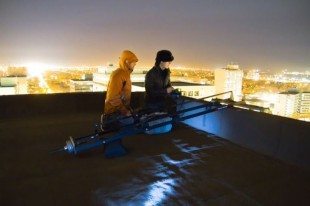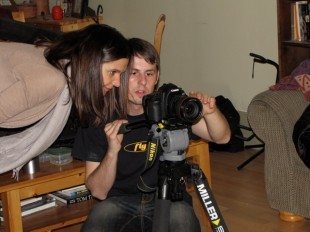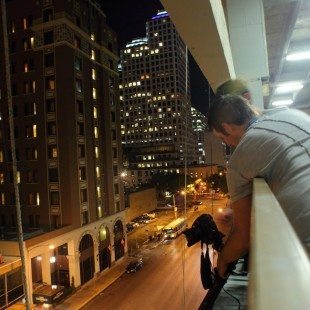**Note: I am not an expert — these are just my opinions on collaboration. I will also be focusing on how it relates to film making and will provide some real world examples. Comments are encouraged :)**
Collaboration is the Key to Success
By Preston Kanak
Collaboration is the key to success in virtually every situation. It not only allows you to focus on a specific element of the creative process, but it also brings a fresh set of eyes to a project. In virtually all collaborative projects, new ideas and perspectives lead to something unique. Collaboration also allows you to draw upon a knowledge base that would otherwise be inaccessible by taking advantage of tools and skill sets unique to each individual. Most importantly however, collaboration helps form new relationships, establish new audiences, and in most cases, substantially improve the final product.
Taking Extreme Measures
 One of the best examples of how collaboration was the impetus for success in film making was with the film El Mariachi by Robert Rodriguez. In 1992, this film was produced for $7,000 and was targeted towards the home video audience. However, Columbia Pictures ended up buying the American distribution rights, making it Rodriguez’s break-out hit.
One of the best examples of how collaboration was the impetus for success in film making was with the film El Mariachi by Robert Rodriguez. In 1992, this film was produced for $7,000 and was targeted towards the home video audience. However, Columbia Pictures ended up buying the American distribution rights, making it Rodriguez’s break-out hit.
This film would not have been made if it wasn’t for the collaboration of many individuals involved in the project (although almost half the financing came from Rodriguez’s participating in experimental clinical drug testing). For example, actors were forced to also act as crew members and real-life people were used as characters in the film. This example is obviously an extreme form of collaboration but if it wasn’t for collaboration, this film would not have been made.
Collaboration Comes in Many Forms (Here are 3)
 Collaboration can be broken down into many areas. For this article, I am going to focus on three different forms of collaboration. It can exist in either roles, relationships, or skill sets. For collaboration to exist in roles, it is key that the people you are working with specialize in a specific area of production — different than what you specialize in. For example, if you specialize in cinematography, it makes sense to find someone who specializes in editing or vise versa. This form of collaboration is present in virtually all productions.
Collaboration can be broken down into many areas. For this article, I am going to focus on three different forms of collaboration. It can exist in either roles, relationships, or skill sets. For collaboration to exist in roles, it is key that the people you are working with specialize in a specific area of production — different than what you specialize in. For example, if you specialize in cinematography, it makes sense to find someone who specializes in editing or vise versa. This form of collaboration is present in virtually all productions.
The second and most common form of collaboration are relationships, both working and personal. When starting out, I found it very helpful to collaborate with an adviser/mentor figure. The transfer of knowledge that happens in these relationships are invaluable. Now, I turn to my colleagues for advise/recommendations/constructive criticism. It is absolutely key to have people you can turn to. One thing to keep in mind however, is that you should not forgo your own opinions about your work. Be open-minded and willing to take constructive criticism but also stick to your guns in some situations. A lot of the time it boils down to taste. For example, Eric Kessler likes Dub Step. Philip Bloom doesn’t :). Most of these decisions are based on your client or target audience.
The last form of collaboration that I am going to touch on is collaboration by skill set. Similar to roles, this one focuses on your strengths. When working in a team environment, such as on an indie film set, everyone has a dedicated responsibility on set. However, if someone needs help, you help them. Everyone is working towards a common goal and it is this approach that I prefer in most situations.
Collaboration is Common
 Collaboration is extremely common in virtually every industry. Many workplaces function with multiple departments that work in unison towards a common goal. It is extremely rare to find a single individual in charge of everything (although somewhat commonplace for independent freelancers). It is far more likely and practical for people to build upon their strengths and focus on developing your skill set.
Collaboration is extremely common in virtually every industry. Many workplaces function with multiple departments that work in unison towards a common goal. It is extremely rare to find a single individual in charge of everything (although somewhat commonplace for independent freelancers). It is far more likely and practical for people to build upon their strengths and focus on developing your skill set.
Collaboration is extremely important for start up businesses (freelancers). This can come in many forms. In many situations, I find that I play many roles in a production and am able to comfortably produce, shoot, edit, and write but I also know that a project is MUCH stronger when I bring on a team to help. In situations when I am doing it all myself, I make sure to ask colleagues their opinions before sending to a client. That extra set of eyes is key. Another way in which you can collaborate is by sharing resources (equipment). One of the biggest obstacles for film makers starting out is the ability to afford new gear. When I started out, and even now, I borrow equipment as much as possible as it keeps the overhead costs low.
A Focused Approach
Building upon the role approach, by working with a team you are able to focus on a specific aspect of the production. Instead of having to worry about every element of production, when you collaborate, you are able to rely on others to perform tasks that you otherwise would have had to take care of. This allows you to focus on what you are good at.
There is always a new way to approach a situation and it is really hard to become a master in a specific field, especially when technology is involved. However, when you are able to focus your energy in one area, you have a much better chance of pushing your creative boundaries. In my short time with film making, I have found that I was only able to push my abilities so far without the help of others. The second I started to incorporate the advice and skill set of others, my quality of work improved drastically.
A New Vision
 No matter the scale of production, I always try something new — be it a new editing or story-telling technique. It is critical that when you are producing a film that you try and push boundaries and try things in new ways. By bringing on other people to collaborate, you are also introducing unique perspectives and this is key. You are able to draw upon pieces of each others vision to create a cohesive idea — introducing a new idea and a new way of looking at something. This happens many times on larger scale productions.
No matter the scale of production, I always try something new — be it a new editing or story-telling technique. It is critical that when you are producing a film that you try and push boundaries and try things in new ways. By bringing on other people to collaborate, you are also introducing unique perspectives and this is key. You are able to draw upon pieces of each others vision to create a cohesive idea — introducing a new idea and a new way of looking at something. This happens many times on larger scale productions.
Collaboration also forces you to accept other people’s viewpoints and perspectives. I come from an indie background and have a specific way/style in which I like to do things. When you collaborate, you are taken out of your comfort zone and encouraged to see things in a new way — which is super important because the people you are collaborating with are as much your audience as is everyone else! However, you MUST be open to their ideas and be willing to move outside your comfort zones — and also forced to grow thick skin.
When working with others, you are exposed to things you may never see or hear and the more you collaborate, the more diverse your work will become. One such example is music selection. Recently, I produced a video with music I felt fit the mood of the piece perfectly. However, a friend of mine recommended a completely different piece of music that ended up evoking a completely different emotion that actually fit the piece much better then what I had picked. The piece would not of been as good as it was if I wasn’t willing to try new things.
Forming New Relationships
 Relationship building on both a personal and professional level are very important aspects of film making — if not more important than the actual film making itself. It is important to view relationship building as an investment. Positive experiences will more than likely lead to more work and this is the ultimate goal.
Relationship building on both a personal and professional level are very important aspects of film making — if not more important than the actual film making itself. It is important to view relationship building as an investment. Positive experiences will more than likely lead to more work and this is the ultimate goal.
Forming new relationships opens up opportunities you otherwise would not have had access to. Everyone has a set of contacts and a pool of talent they draw upon. If you are able to gain access to this list by simply providing something in return, you are only increasing your chances of success. It’s about give and take — just like in any relationship.
Establishing New Audiences
For me, one of the biggest driving forces for collaboration has been the way in which new audiences are established. Normally when I produce a film, I only have access to the people who are following my work. However, when you collaborate with others, you have now gained access to the collaborators audience as well via social media and other avenues. If this doesn’t drive someone to collaborate then I don’t know what will ;).
The Final Product
Although just a brief look at why collaboration is key, it is easy to see it’s importance. By collaborating with others, you are able to draw upon a wealth of knowledge from people with completely different life experiences. It opens up opportunities you otherwise would not have had. Most importantly however, it helps generate a new vision, new audiences, and new relationships.
Below are two different pieces I recently produced in two very different collaborative projects.
Karrnnel – Coast/Rain – ‘A Clear Vision’
About the Film
For this film, I collaborated with four other artists/musicians (Karrnnel, Louis-Charles Vigneau, Daniel Koulack, & Amy Matysio). We wanted to capture a live jam session. In relation to our collaborative model, we took the skill set approach — focusing on everyone’s strengths but also helping each other in areas that weren’t covered. We only had an hour and a half to set everything up and film the project so we were all forced to pitch in and help. When it came to editing, I edited it all together, relying on the artists to make note of sections that had instruments out of sync as the final recording was not the same as what they were playing live. Amy, who acted as the creative director and co-producer/co-director, set the tone/grading for the piece.
Composer: Karrnnel
Fiddle: Karrnnel
Guitar: Louis-Charles Vigneau
Double Bass: Daniel Koulack
Produced by Amy Matysio, Preston Kanak & Karrnnel
Filmed & Edited by Preston Kanak
Triple Americano – ‘A Fresh Set of Eyes’
About the Film
This project was filmed over a week and a half and I wanted to encompass as many filmmakers in it as time would allow. It was filmed in Regina, Saskatchewan & Ausin, Texas. In regards to the approach, I based it off of all the above forms of collaboration (roles, relationships & skill set). Everyone involved helped at various stages of the video. First, they helped shoot it (roles) — focusing on their skills as a shooter, and then they gave feedback on the film once it was edited (building on both the relationship and skill set approach).
List of Filmmakers
Dustin & Zach Wilson
Riley Moynes
Jeremy Drummond
Michael Pavlovsky
Andrew Taran
Braden Jobson
Daniel Lowe
Eric Kessler
Joel Graves


20 comments
Couldn’t Agree more – we could never have made Zomblies or started The UnderWaterRealm without collaboration from hundreds of like-minded filmmakers
Look what is possible when you work with a great team of volunteers!
http://www.kickstarter.com/projects/realmpictures/explore-the-underwater-realm/backers
TheUnderWaterRealm looks extremely involved/interesting!
I hope you’re able to continue to move forward with the funding you need, and I’ll certainly be checking out Zomblies in the near future.
brilliant article! Collaboration is something I’ve been working on lately, so thanks for the inspiration!
Agreed! Sometimes it can be difficult to good/reliable help that you can be 100% confident in, but it’s such a great feeling/value when you do.
What a great post. Yesterday I (a wedding filmmaker) joint forces with some photographers (something that was 6 months in the making).
It’s cool to wake up the next morning and read an article bang in line with how we feel and why we ‘collaborated’!
Great post, there is nothing better than cross pollinating with others.
Nicely done.
From the little experience I have found the one thing in my life that I know is true is that in this biz there are a lot of people who can be mean a hurtful, But the smart ones and the truly good ones are those who treat every one on set with dignity and respect with that added patience and kindness. Even towards the production assistants. because you never know in this business who might rise up and who might fall. I’d rather have people around me that can give me that initial respect even if I may be off with my logic at times. we are all not perfect and a person who can pass my personally test is a person worth having as a quality friend or college. Also having people that can lift you up as an artist is so pivotal in the role of making any content. Working with million doller projects I can say first hand that with out that initial respect there is no project because those who can not give others respect WILL tare others and my self included down and sabotage productions for the sake of greed or other selfish motives. This is the one lesson I have learned the hard way. But its one lesson I am glad I got to experience first hand. Thats why we see these tight film groups because there are too many people out there trying to destroy others.
I really dig this post, Philip–just decided to read it again.
I just finished up a project a couple of weeks ago, that was absolutely dependent on collaboration. As a result, it was one of my favorite and one of my strongest projects to date (because of both the working-relationships involved, and talent of the people involved).
It’s a doc-style short about a comedy club in Minnesota that is truly a comedians’ club. The content is actually relevant to this post too, as the video is sort of about collaboration as well—the club encourages comedians to experiment, push themselves, and therefore grow–audience is more open to new material–the comedians try new things, and everyone has a great experience.
Anyway, I believe the video is relevant to this thread on multiple levels, and I’d love for anyone to check it out–whether it be you, Philip, or the rest of the gang!
http://vimeo.com/32157365
Thanks for the share!
Thank YOU for checking it out, Preston!
AND, my apologies for the false attribution there–great article *Preston*!
(I knew the vids were yours, but didn’t realize right away that the article was as well)
I fully support the opinion of P. Bloom about Collaboration in creating films. It is essential to work with people who are not only naturally complement your weak point or points, but also it is the easiest way to improve your skills.
This is a project which is done mainly through cooperation. Almost without money ($ 200), without professional gear and finally WITHOUT TIME for serious post or effects. Shot in 3 days. Post-production about two and half weeks – 3 people (editing, color grading, effects) + music composer.
I hope you like it. Replies are encouraged.
http://vimeo.com/33107720
Great piece. Loved the style.
Thanks. This movie was a milestone for me as a filmmaker. Now i’m writing script for full length movie and searching for some budget opportunities. In Poland, making movies is a really hard thing. Even harder if you want to do your first film.
Agreed! Great shots, great pacing, great grading, great locations, great effects!
It seems that the author of the text is not Bloom, but Preston P Kanak. I need to learn read with understanding :-). Dear Author accept my apology.
Nice Article Man
Here what francis ford coppala says on collaboration
http://www.scoop.it/t/cimaginations/p/490901347/interview-francis-ford-coppola-on-risk-money-craft-collaboration
Awesome! Thanks for the share!
Totaly agree Philip, colloboration is a great way to offer and share information and understand technique and equipment.
http://www.personal-view GH2 users recently embarked on a showreel colloboration to demonstrate the qualities of the INTRA patch.
http://vimeo.com/32563119
Now these same guys (and quite a few more) are getting together to produce a movie length feature from colloborative groups from all corners of the globe voting on an original theme and script. Any interested Panasonic GH2 users should see this link;-
http://www.personal-view.com/talks/discussion/1532/personal-view-feature-film-collaborative-proyect#Item_236
test